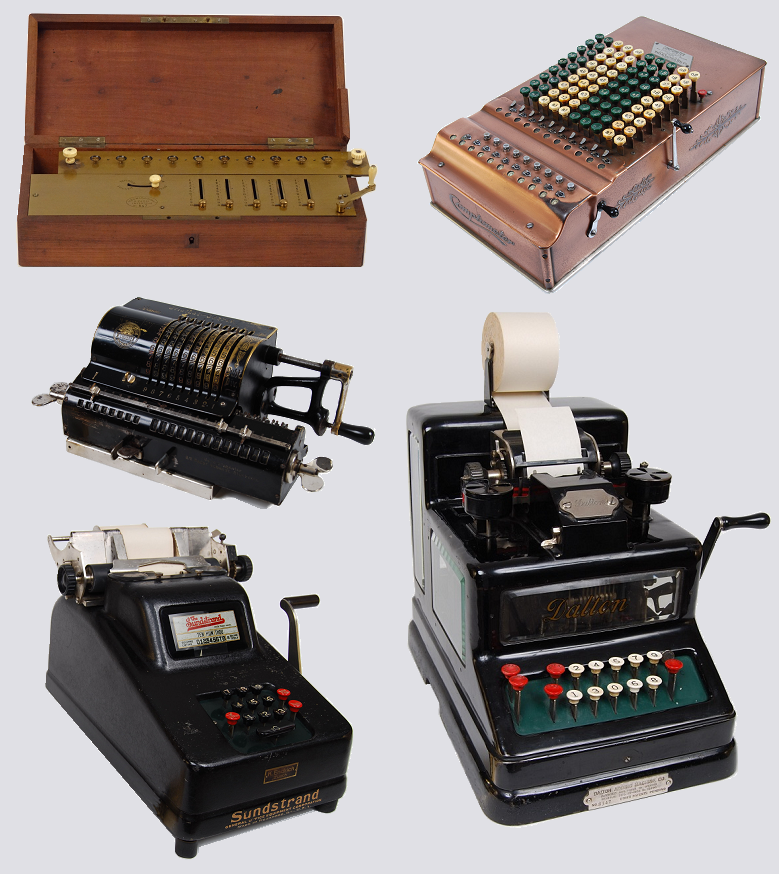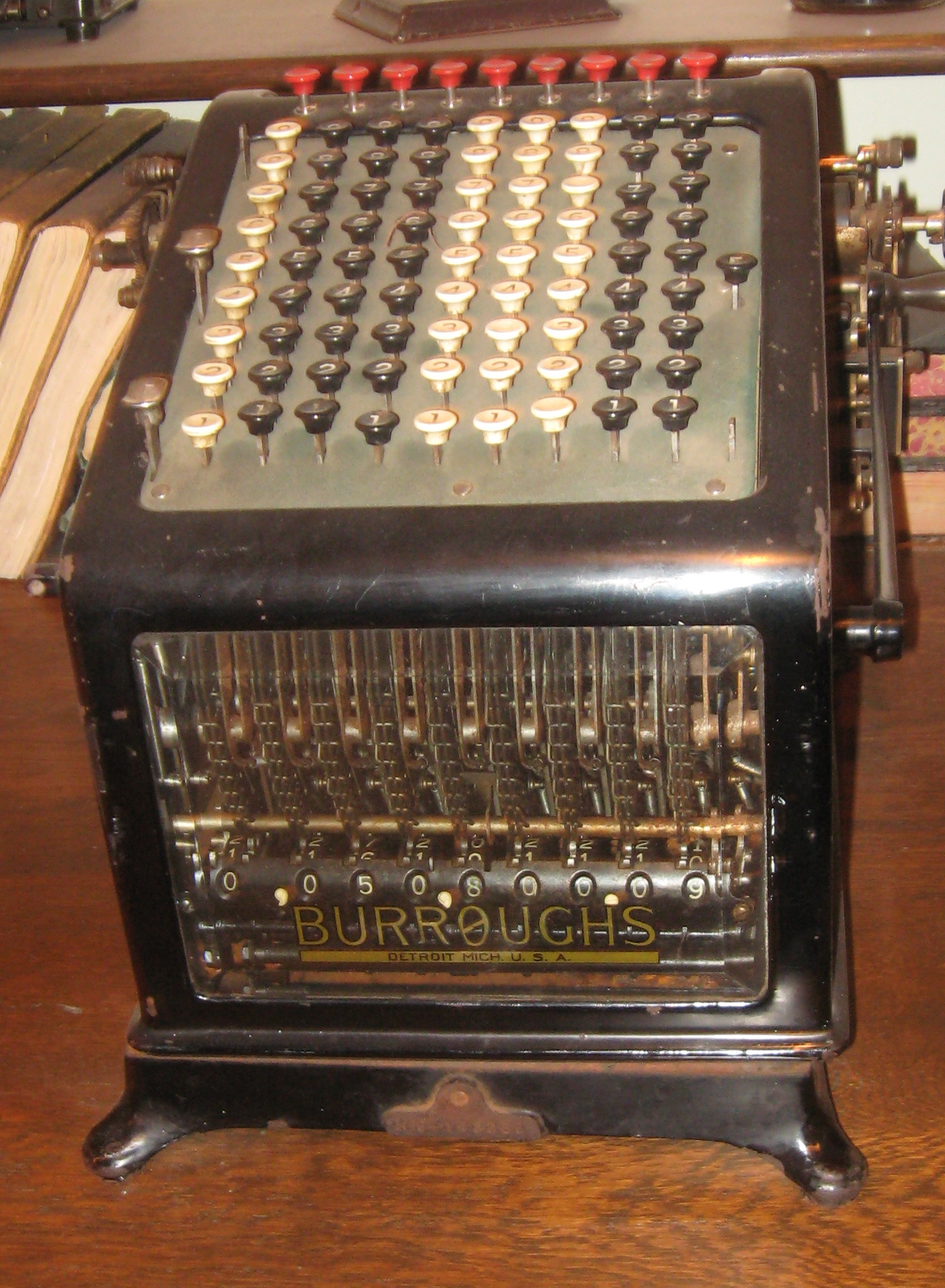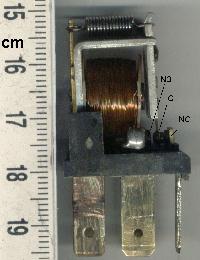 |
Adding Machine
An adding machine is a class of mechanical calculator, usually specialized for bookkeeping calculations. Consequently, the earliest adding machines were often designed to read in particular currencies. Adding machines were ubiquitous office equipment in developed countries for most of the twentieth century. They were phased out in favor of electronic calculators in the 1970s and by personal computers beginning in about 1985. Blaise Pascal and Wilhelm Schickard were the two original inventors of the mechanical calculator in 1642. For Pascal, this was an adding machine that could perform additions and subtractions directly and multiplication and divisions by repetitions, while Schickard's machine, invented several decades earlier, was less functionally efficient but was supported by a mechanised form of multiplication tables. These two were followed by a series of inventors and inventions leading to those of Thomas de Colmar, who launched the mechanical calculator indus ... [...More Info...] [...Related Items...] OR: [Wikipedia] [Google] [Baidu] |
 |
Mechanical Calculating Machine
A mechanical calculator, or calculating machine, is a mechanical device used to perform the basic operations of arithmetic automatically, or a simulation like an analog computer or a slide rule. Most mechanical calculators were comparable in size to small desktop computers and have been rendered obsolete by the advent of the electronic calculator and the digital computer. Surviving notes from Wilhelm Schickard in 1623 reveal that he designed and had built the earliest known apparatus fulfilling the widely accepted definition of a mechanical calculator (a counting machine with an automated tens-carry). His machine was composed of two sets of technologies: first an abacus made of Napier's bones, to simplify multiplications and divisions first described six years earlier in 1617, and for the mechanical part, it had a dialed Pedometer#History, pedometer to perform additions and subtractions. A study of the surviving notes shows a machine that could have jammed after a few entries on ... [...More Info...] [...Related Items...] OR: [Wikipedia] [Google] [Baidu] |
 |
Dorr Felt
Dorr Eugene Felt (March 18, 1862 – August 7, 1930) was an American inventor and industrialist who was known for having invented the Comptometer, an early computing device, and the Comptograph, the first printing adding machine. The ''Felt & Tarrant Manufacturing Company'' that he co-founded with Robert Tarrant on January 25, 1889 J. Turk, p. 75 (1921) remained a major player in the calculator industry until the mid-1970s. Biography Dorr E. Felt was born in Beloit, Wisconsin Felt and Allied Families, p. 12 (1921) where he grew up on the family farm and which he left at age 14 to seek employment. His father, Eugene K. Felt, was a member of the Wisconsin State Assembly. At 16, "his bent of mind, leaning towards mechanics, led him to seek work in a machine shop in Beloit where he found his first employment in the spring of 1878." At 18, he started to learn French and eventually spoke it fluently. Papers in Illinois, p.66 (1922) In early 1882, at age 20, he came to Chicago and ... [...More Info...] [...Related Items...] OR: [Wikipedia] [Google] [Baidu] |
|
William S
William is a masculine given name of Germanic languages, Germanic origin. It became popular in England after the Norman Conquest, Norman conquest in 1066,All Things William"Meaning & Origin of the Name"/ref> and remained so throughout the Middle Ages and into the modern era. It is sometimes abbreviated "Wm." Shortened familiar versions in English include Will (given name), Will or Wil, Wills, Willy, Willie, Bill (given name), Bill, Billie (given name), Billie, and Billy (name), Billy. A common Irish people, Irish form is Liam. Scottish people, Scottish diminutives include Wull, Willie or Wullie (as in Oor Wullie). Female forms include Willa, Willemina, Wilma (given name), Wilma and Wilhelmina (given name), Wilhelmina. Etymology William is related to the German language, German given name ''Wilhelm''. Both ultimately descend from Proto-Germanic ''*Wiljahelmaz'', with a direct cognate also in the Old Norse name ''Vilhjalmr'' and a West Germanic borrowing into Medieval Latin ''Wil ... [...More Info...] [...Related Items...] OR: [Wikipedia] [Google] [Baidu] |
|
 |
Beat Generation
The Beat Generation was a literary subculture movement started by a group of authors whose work explored and influenced American culture and politics in the post-World War II era. The bulk of their work was published and popularized by members of the Silent Generation in the 1950s, better known as Beatniks. The central elements of Beat culture are the rejection of standard narrative values, making a spiritual quest, the exploration of American and Eastern religions, the rejection of economic materialism, explicit portrayals of the human condition, experimentation with psychedelic drugs, and sexual liberation and exploration. Allen Ginsberg's '' Howl'' (1956), William S. Burroughs' ''Naked Lunch'' (1959), and Jack Kerouac's ''On the Road'' (1957) are among the best-known examples of Beat literature.Charters (1992) ''The Portable Beat Reader''. Both ''Howl'' and ''Naked Lunch'' were the focus of obscenity trials that ultimately helped to liberalize publishing in the United State ... [...More Info...] [...Related Items...] OR: [Wikipedia] [Google] [Baidu] |
|
Unisys
Unisys Corporation is a global technology solutions company founded in 1986 and headquartered in Blue Bell, Pennsylvania. The company provides cloud, AI, digital workplace, logistics, and enterprise computing services. History Founding Unisys’ history dates back to 1873 with E. Remington & Sons and the introduction of the first commercially viable typewriter to use the QWERTY keyboard layout. Over a hundred years later, the company became known as Unisys in 1986 through the merger of Mainframe computer, mainframe corporations Sperry Corporation, Sperry and Burroughs Corporation, Burroughs, with Burroughs buying Sperry for $4.8 billion. The new company's name was chosen from over 31,000 submissions in an internal competition when Christian Machen submitted the word "Unisys", which was composed of parts of the words "united", "information", and "systems". The merger was the largest in the computer industry at the time and made Unisys the second-largest computer company wit ... [...More Info...] [...Related Items...] OR: [Wikipedia] [Google] [Baidu] |
|
|
Sperry Corporation
Sperry Corporation was a major American equipment and electronics company whose existence spanned more than seven decades of the 20th century. Sperry ceased to exist in 1986 following a prolonged hostile takeover bid engineered by Burroughs Corporation, which merged the combined operation under the new name Unisys. Some of Sperry's former divisions became part of Honeywell, Lockheed Martin, Raytheon Technologies, and Northrop Grumman. The company is best known as the developer of the artificial horizon and a wide variety of other gyroscope-based aviation instruments like autopilots, bombsights, analog ballistics computers and gyro gunsights. In the post-WWII era the company branched out into electronics, both aviation-related, and later, computers. The company was founded by Elmer Ambrose Sperry. History Early history The company was incorporated on April 14 1910 by Elmer Ambrose Sperry as the Sperry Gyroscope Company, to manufacture navigation equipment—chief ... [...More Info...] [...Related Items...] OR: [Wikipedia] [Google] [Baidu] |
|
 |
Burroughs Corporation
The Burroughs Corporation was a major American manufacturer of business equipment. The company was founded in 1886 as the American Arithmometer Company by William Seward Burroughs I, William Seward Burroughs. The company's history paralleled many of the major developments in history of computing, computing. At its start, it produced mechanical adding machines, and later moved into programmable ledgers and then computers. It was one of the largest producers of mainframe computers in the world, also producing related equipment including typewriters and Printer (computing), printers. In the 1960s, the company introduced a range of mainframe computers that were well regarded for their performance running high level languages. These formed the core of the company's business into the 1970s. At that time the emergence of superminicomputers and the dominance of the IBM System/360 and 370 at the high end led to shrinking markets, and in 1986 the company purchased former competitor Sperry C ... [...More Info...] [...Related Items...] OR: [Wikipedia] [Google] [Baidu] |
 |
Paper Tape
Five- and eight-hole wide punched paper tape Paper tape reader on the Harwell computer with a small piece of five-hole tape connected in a circle – creating a physical program loop Punched tape or perforated paper tape is a form of data storage that consists of a long strip of paper through which small holes are punched. It was developed from and was subsequently used alongside punched cards, the difference being that the tape is continuous. Punched cards, and chains of punched cards, were used for control of looms in the 18th century. Use for telegraphy systems started in 1842. Punched tapes were used throughout the 19th and for much of the 20th centuries for programmable looms, teleprinter communication, for input to computers of the 1950s and 1960s, and later as a storage medium for minicomputers and CNC machine tools. During the Second World War, high-speed punched tape systems using optical readout methods were used in code breaking systems. Punched tape was used to t ... [...More Info...] [...Related Items...] OR: [Wikipedia] [Google] [Baidu] |
 |
Calculator
An electronic calculator is typically a portable electronic device used to perform calculations, ranging from basic arithmetic to complex mathematics. The first solid-state electronic calculator was created in the early 1960s. Pocket-sized devices became available in the 1970s, especially after the Intel 4004, the first microprocessor, was developed by Intel for the Japanese calculator company Busicom. Modern electronic calculators vary from cheap, give-away, credit-card-sized models to sturdy desktop models with built-in printers. They became popular in the mid-1970s as the incorporation of integrated circuits reduced their size and cost. By the end of that decade, prices had dropped to the point where a basic calculator was affordable to most and they became common in schools. In addition to general-purpose calculators, there are those designed for specific markets. For example, there are scientific calculators, which include trigonometric and statistical calculat ... [...More Info...] [...Related Items...] OR: [Wikipedia] [Google] [Baidu] |
 |
Electromechanical
Electromechanics combine processes and procedures drawn from electrical engineering and mechanical engineering. Electromechanics focus on the interaction of electrical and mechanical systems as a whole and how the two systems interact with each other. This process is especially prominent in systems such as those of DC or AC rotating electrical machines which can be designed and operated to generate power from a mechanical process ( generator) or used to power a mechanical effect ( motor). Electrical engineering in this context also encompasses electronics engineering. Electromechanical devices are ones which have both electrical and mechanical processes. Strictly speaking, a manually operated switch is an electromechanical component due to the mechanical movement causing an electrical output. Though this is true, the term is usually understood to refer to devices which involve an electrical signal to create mechanical movement, or vice versa mechanical movement to create an ele ... [...More Info...] [...Related Items...] OR: [Wikipedia] [Google] [Baidu] |
|
Comptometer
The Comptometer was the first commercially successful key-driven mechanical calculator, patented in the United States by Dorr Felt in 1887. A key-driven calculator is extremely fast because each key adds or subtracts its value to the accumulator as soon as it is pressed and a skilled operator can enter all of the digits of a number simultaneously, using as many fingers as required, making them sometimes faster to use than electronic calculators. Consequently, in specialized applications, comptometers remained in use in limited numbers into the early 1990s, but with the exception of museum pieces, they have all now been superseded by electronic calculators and computers. Manufactured without interruption from 1887 to the mid-1970s, it was constantly improved. The mechanical versions were made faster and more reliable, then a line of electro-mechanical models was added in the 1930s. It was the first mechanical calculator to receive an all-electronic calculator engine in 1961, wit ... [...More Info...] [...Related Items...] OR: [Wikipedia] [Google] [Baidu] |